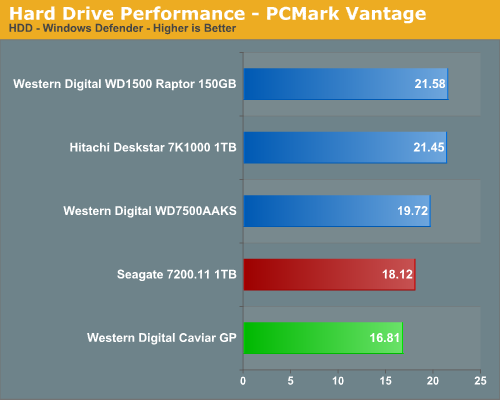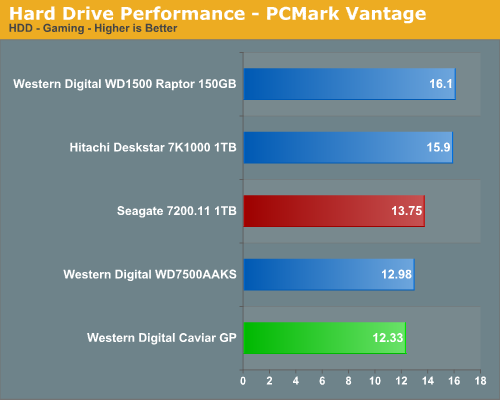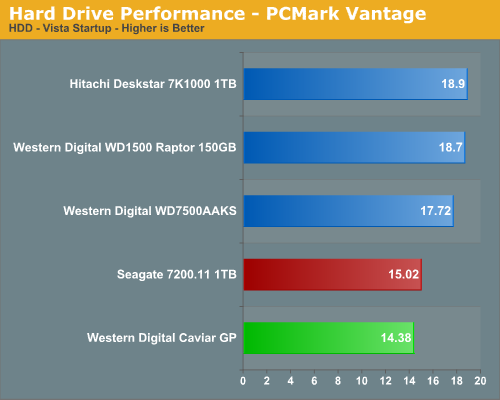Seagate and Western Digital 1TB Drives: Improved and Green
by Dave Robinet on November 26, 2007 7:00 AM EST- Posted in
- Storage
Windows Vista
Vista (and its associated drivers and applications) has finally matured to the point where we feel comfortable including it in our benchmark suite. To that end, we are pleased to include the following as our inaugural Vista storage selections:
- Windows Vista Startup / Shutdown
- PCMark Vantage
Going forward, we will continue to expand the Vista benchmark and application selection as they become ready for prime time. With this in mind, we have chosen not to include hibernation benchmarks in our initial round of testing due to related issues with Vista. Service Pack 1 should go a long way towards resolving these issues (and initial looks at the latest release candidate suggest that it does), so we will revisit this decision when the final release of SP1 comes out.
Our Vista strategy follows the one we are using for Windows XP. We apply only major milestone releases (SP1, SP2, etc) and keep drivers updated as necessary. Whenever there is a major driver (or OS) update, we will go back and re-run previous benchmarks to ensure that the data set remains consistent. For our tests, we disable Windows Defender, set the paging file to a static 3.0GB in size, and limit the Recycle Bin to 1GB maximum. We also close the Sidebar application.
PCMark Vantage
PCMark Vantage is the latest benchmark available from Futuremark, and is available only on Windows Vista. Similar to the venerable PCMark05 in its makeup, Vantage modernizes the criteria and test methodology to reflect what users may encounter when running the new Windows OS.
For the HD test suite, the white paper breaks the tests down as:
- Windows Defender: Windows Defender performs a scan operation, resulting in a read-intensive (99.5% read, 0.5% write) benchmark reflecting a common task in Windows Vista.
- Gaming Performance: Streaming performance is measured using actual game mechanics found in Alan Wake. This test is nearly all read (99.95% read, 0.05% write) in nature.
- Windows Photo Gallery: A large collection of images is imported into Windows Photo Gallery. This is the first of the tests which bring write performance into account in a meaningful way, with a roughly 84% read, 16% write ratio.
- Windows Vista Startup: Simulates Windows Vista start-up operations, producing a test that breaks down to roughly 85% read and 15% write operations.
- Windows Movie Maker: The first of the Vantage tests which comes close to equally dividing read and write operations (54% read, 46% write), concurrent video performance is tested both for video read and skip performance, as well as video write operations.
- Windows
Media Center: Performing three distinct tasks:
- SDTV video playback
- SDTV video streaming to Extender for Windows Media Center
- SDTV video recording
- Windows Media Player: Adds music to Windows Media Player. This test reverts to favoring read operations (78% read, 22% write).
- Application
Loading: The following applications are loaded:
- Microsoft Word 2007
- Adobe Photoshop CS2
- Internet Explorer 7
- Outlook 2007
The total benchmark is roughly 87% reads and 13% writes in nature. We run each test five times per drive, producing a median score that we use for comparison in our charts.















31 Comments
View All Comments
retrospooty - Monday, November 26, 2007 - link
I for one found the article helpful. It isn't about showing performance and choosing a winner based on speed, it is about showing all aspects of each and letting the buyer decide. Some people might want pure speed, and some might want a low power, quieter option.I think logic is lost on some people.
gmyx - Monday, November 26, 2007 - link
While 4w may not seem like much to a power user, it is a big deal to someone who is building a low power system such as a VIA based system. It's obviously not going to be used for playing games but can certainly work as a file server / internet proxy. When you can get a power supply with a total output of 60w (pico 60w power supply) every watt saved brings your total lower. A lower total mean less cost for your file server / internet proxy.Lonyo - Tuesday, November 27, 2007 - link
I would imagine it would also be nice for a low power home file server.1 of these 1TB drives would use probably <1/3rd of the power of 2x500GB drives, or ~1/2 the power of another 1TB drive.
If you have say a RAID-5 array with 5 or 6 of these drives, you're looking at a decent reduction in power which is always nice for a 24/7 machine.
Googer - Monday, November 26, 2007 - link
Those who have wanted to use low power hard drives on a desktop motherboard have always had the option of using 2.5" laptop drives.Dave Robinet - Monday, November 26, 2007 - link
Well put, Jarred.The Hitachi was reviewed some time ago, now, and (as you mention) its results are included in the charts. It gets mention in the conclusion as being the preferred option over the Seagate, as well.
The Green drive does have a place as a quiet drive (the quietest of the 1TB drives tested), and it comes at a low price point. That's considerable - particularly for HTPC users, who may not appreciate the Hitachi's noise.
For performance-oriented applications, though, it's a tough sell.
DigitalFreak - Monday, November 26, 2007 - link
Me thinks that this whole "green" thing from WD is because they were having issues producing a performance drive. Maybe the lower power consumption would make sense in a laptop drive, but I'd much rather have performance on the desktop.Seagate's ATA drives have always been so-so performers, so I'm not surprised with the outcome. However, they 5 year warranty more than makes up for it in a home server environment.
jojo4u - Monday, November 26, 2007 - link
Other drives are performing well. It's nice to have the choice. And there are uses for low-power high-capacity drives.jojo4u - Monday, November 26, 2007 - link
See page 2 and page 3 http://www.storagereview.com/1000.sr?page=0%2C2">http://www.storagereview.com/1000.sr?page=0%2C2Your low-level results also back this up.
DigitalFreak - Monday, November 26, 2007 - link
There was a discussion on their forums about how it would be prohibitively expensive to produce a drive that could vary it's spindle speed due to the extra stress on the mechanism.Interlink - Tuesday, November 27, 2007 - link
Anybody with a mic e.g. in his headset and a PC with microphon input is able to measure the fixed spindle speed of a WD10EACS: [url=http://forums.storagereview.net/index.php?showtopi...">http://forums.storagereview.net/index.p...c=26021&...]5400 rpm[/url].